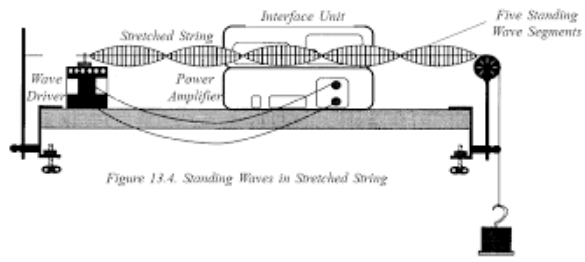Objectives:
- To understand the stationary wave patterns for a stretched string and air columns in closed and open tubes
- To identify techniques and procedures used to determine the speed of sound in air by formation of stationary waves in a resonance tube
- To appreciate the idea that the separation between adjacent nodes (or antinodes) is equal to
, where
is the wavelength of the progressive wave
- To understand what the fundamental mode of vibration (1st harmonic) is as well as the term harmonics
Observing standing waves

A string is attached at one end to a vibration generator, driven by a signal generator. The other end hangs over a pulley and weights maintain the tension in the string. When the signal generator is switched on, the string vibrates with small amplitude. However, by adjusting the frequency, it is possible to produce stationary waves whose amplitude is much larger. The pulley end of the string is unable to vibrate, so this has to be a node. Similarly the end attached to the vibrator is only able to move a small amount so this is also a node. As frequency is increased, it is possible to observe one loop (one antinode only) at the start, then two loops, and three and so on. A flashing stroboscope is useful to reveal the motion of the string at these frequencies, which will look blurred to human eyes. The frequency of vibration is set so that there are two loops along the string. The frequency of the stroboscope is also set so that it almost matches that of the vibrations. Now we can see the string moving in slow motion.
Furthermore, the speed of the wave can be deduced from this setup. If the frequency of the stroboscope is adjusted such that the loops become visible, the frequency can be read off the stroboscope and hence be known. Using a ruler, the wavelength of the wave can be determined, in figure a there is are complete waves – one loop is equivalent to half a wavelength, this can be shown by using your finger to trace one complete wave along one path (after all the string only exists in one place at a time).
Air columns
 A glass tube (open at both ends) is clamped so that one end dips into a cylinder of water. By adjusting its height in the clamp, you can change the length of the column of air in the tube. When you hold a vibrating tuning fork above the open end, the air column may be forced to vibrate and the note od the tuning fork sounds much louder. The length of the air column though must be just right. The air at the bottom of the tube is unable to vibrate so this point must be a node. The air at the open end of the tube can vibrate freely so this must be an antinode. Hence the length of the air column must be on quarter of wavelength or three quarters or so on.
A glass tube (open at both ends) is clamped so that one end dips into a cylinder of water. By adjusting its height in the clamp, you can change the length of the column of air in the tube. When you hold a vibrating tuning fork above the open end, the air column may be forced to vibrate and the note od the tuning fork sounds much louder. The length of the air column though must be just right. The air at the bottom of the tube is unable to vibrate so this point must be a node. The air at the open end of the tube can vibrate freely so this must be an antinode. Hence the length of the air column must be on quarter of wavelength or three quarters or so on.
Stationary waves and musical instruments
The production of different notes by musical instruments often depends on the creation of stationary waves. For a stringed instrument such as a guitar, the two ends of a string are fixed, so nodes must be established at these points. When the string is plucked half way along its length it vibrates with an antinode at its midpoint. This is known as the fundamental node of vibration of the string. The fundamental frequency is the minimum frequency of a standing wave for a given system or arrangement (it is the minimum frequency so that the standing wave creates one loop).
Similarly the air column inside a wind instrument is caused to vibrate by blowing, and the note that is heard depends on a stationary wave being established. By changing the length of the length of the air column, as in a trombone, the note can be changed. Alternatively, holes can be uncovered so that the air can more freely, giving a different pattern of notes and antinodes. In practice, the sounds that are produced are made up of several different stationary waves having different patterns of nodes and antinodes. For example, a guitar string may vibrate with two antinodes along its length. This gives a note having twice the frequency of the fundamental and is described as a harmonic of the fundamental. The musician’s skill is in stimulating the string or air column to produce a desired mixture of frequencies. The frequency of a harmonic is always a multiple of the fundamental frequency. The diagrams shows some of the modes of vibrations for a fixed length of string and an air column in a tube of a given length that is closed at one end.
Page written by Luca Quinci – Thank you!
Further reading:
- Isaac Physics – Standing waves – This is a reading resource
- Research the physics of pan pipes or other wind instruments.
- The History of the English Organ by Stephen Bicknell – preview



You must be logged in to post a comment.